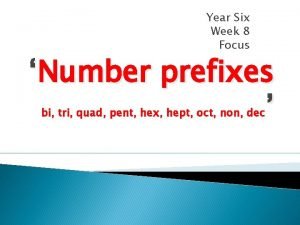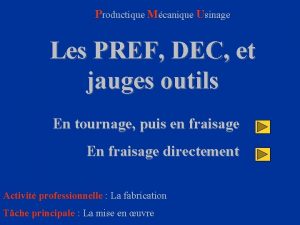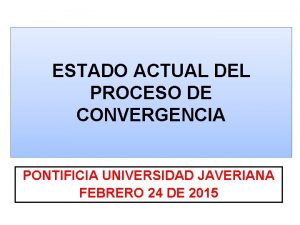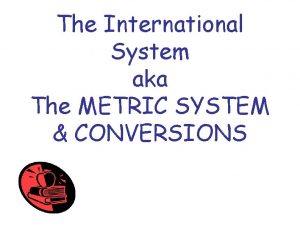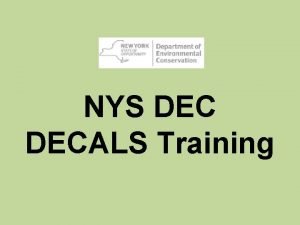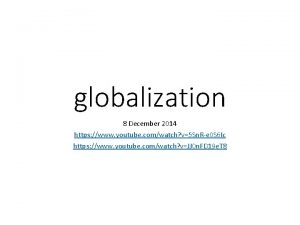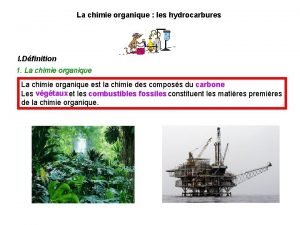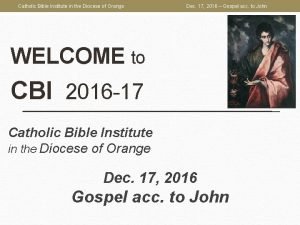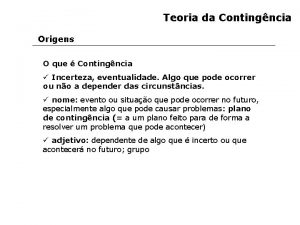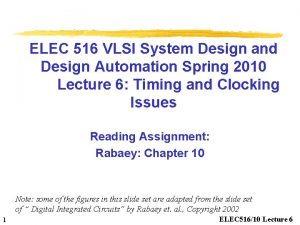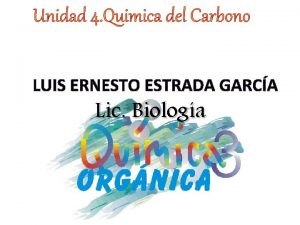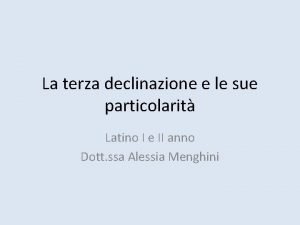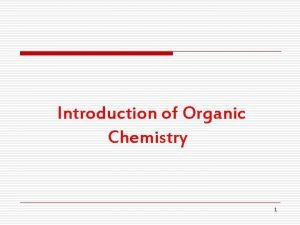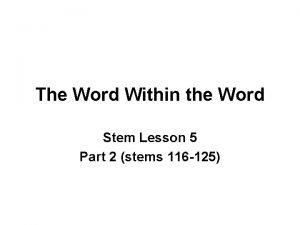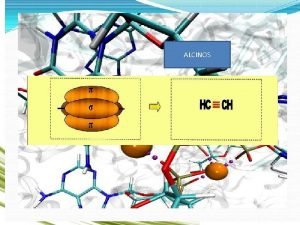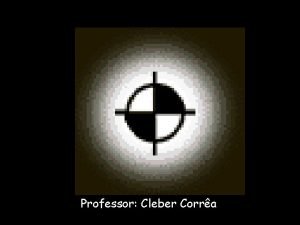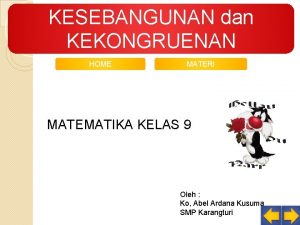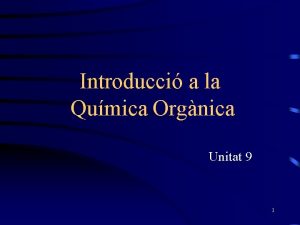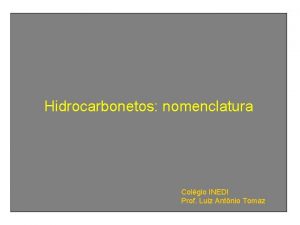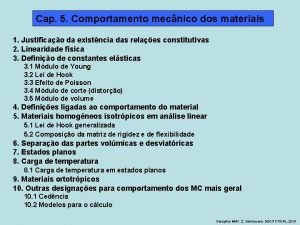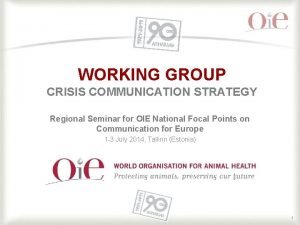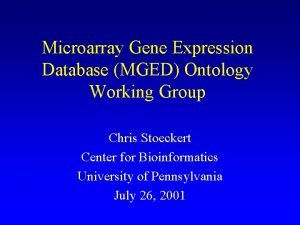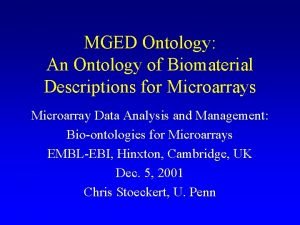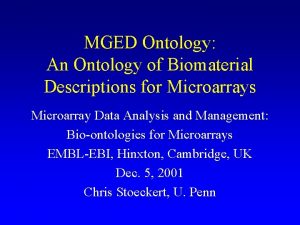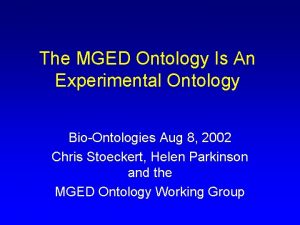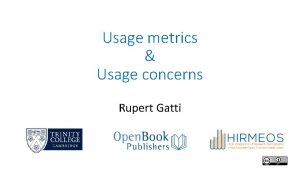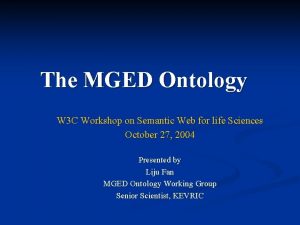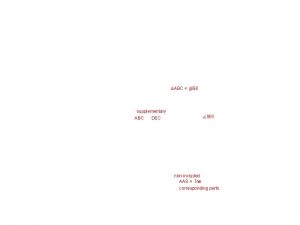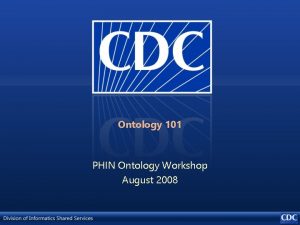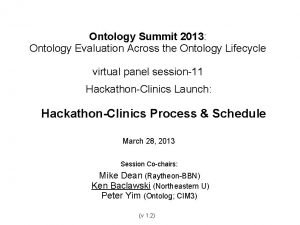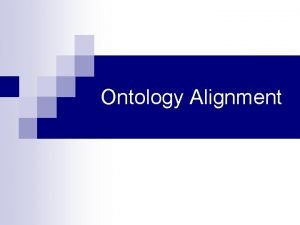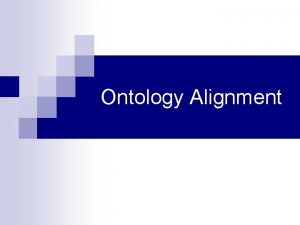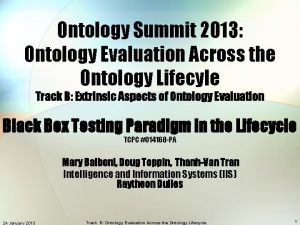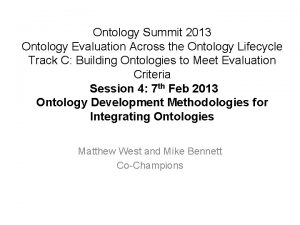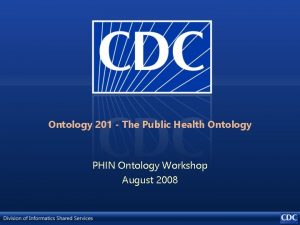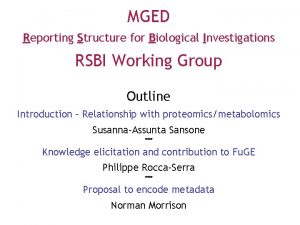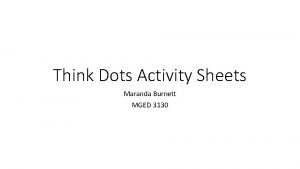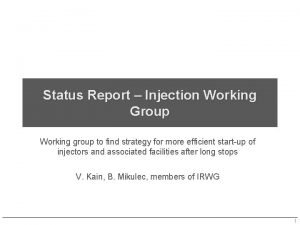MGED Ontology usage MGED Ontology Working Group Dec
![MGED Ontology [--usage] MGED Ontology Working Group Dec, 2003 MGED Ontology [--usage] MGED Ontology Working Group Dec, 2003](https://slidetodoc.com/presentation_image_h2/d0a6413f3b8f8a6fc8c6039da0fa1450/image-1.jpg)




























- Slides: 29
![MGED Ontology usage MGED Ontology Working Group Dec 2003 MGED Ontology [--usage] MGED Ontology Working Group Dec, 2003](https://slidetodoc.com/presentation_image_h2/d0a6413f3b8f8a6fc8c6039da0fa1450/image-1.jpg)
MGED Ontology [--usage] MGED Ontology Working Group Dec, 2003

Outline • Brief overview of MGED Ontology (MO) – Structure of MO – What is in MO – Uses of MO – MAGE and MO • MGED Ontology use policies – Simple examples – Nested term examples – Referencing outside terms with MO

Ontologies in general • Explicit specification of a conceptualization – Defines a vocabulary with which queries and assertions are made • Classes - base type – Animal, Cat, Dog – Bio. Material, Age, Technology. Type – IS-A relationships: Cat IS-A Animal • Properties - attributes of classes – number_of_legs, natural_enemy – HAS-A relationships: Cat HAS 4 legs • Individuals - instantiations of classes – calico, hound, “Stinky Pete” • Axioms - logic statements – Cat != Dog

MGED Ontology (MO) • Core ontology limited to MAGE-OM v. 1. 1 • Extended Ontology augments the Core with terms currently outside the scope of MAGE v. 1. 1 Oil. Ed editor: http: //oiled. man. ac. uk/ Protogé: do google search for it

MAGE and MO

MAGE and MO

Main focus of MGED Ontology • Structured and rich description of Bio. Materials Bio. Material +characteristics Ontology. Entry +associations


A graph representation

MGED Ontology Announcements • http: //www. mged. sf. net/ontologies – About to release first stable release of the Core ontology (version 1. 1. 7) – Provide usage of the ontology and examples – Lot’s of links to ontology resources on the web • Policies – Any term not referenced via Database. Entry is by default user-defined and not part of MO • ‘accession’ and ‘URI’ are not both needed • Refers to Ontology. Entry. value – MO terms may be used in “category” for other ontology’s term (e. g. “Organism”)

Referencing MO Terms <MAGE-ML> … <Database name="The MGED Ontology" identifier="MO" URI="http: //mged. sourceforge. net/ontologies/MGEDontology. php" /> … <Ontology. Entry category="Some. MOClass" value= "some_MO_instance"> <Ontology. Reference_assn> <Database. Entry accession="#some_MO_instance" URI="http: //mged. sourceforge. net/ontologies/MGEDontology. php#some_MO_instance"> <Database_assnref> <Database_ref identifier="MO"/> </Database_assnref> </Database. Entry> </Ontology. Reference_assn> </Ontology. Entry> … </MAGE-ML>

Graph representation of previous slide’s XML

Individuals • Instance term goes into value and is the referenced term. • Parent term goes into category


Classes with Properties • Nested structure via Ontology. Entry. Association • Fillers: – base types (boolean, string, etc. ) – Classes/Instances – Enumeration of Instances • Ontology. Entry category & value = Property • Filler is given as Ontology. Entry Association – follow the rules – When a base type, Ontology. Entry. category = Property

Measurement Example

Enumeration of instances Base type Class/Instance

Enumerated instances example

Base type example

Class/Property example

This is BAD! An example of node skipping or tree collapsing

Including parent classes • You may include parent classes for ease of queries, but you must reproduce all of the structure from the parent to the term of interest

Here we have included the parent term “Action” to the instance term “add” and have included the full term tree.

“Abstract” classes • These are classes without individuals – Usually have “user-defined” instance terms • Term goes in Ontology. Entry “category” and “value” attributes and referenced via Database. Entry • User-defined term is “Association” (or child Ontology. Entry term) with abstract class in category and new term in value, unreferenced • Example: Your Bio. Material source had a Disease “foobar”


Referencing terms in other ontologies • Special case of last slide, were new term optionally references some other ontology via its Database. Entry • In addition, specify from within the MGED Ontology where the term hailed from – Is-a “Ontology. Entry” term has properties: • has_database = source for the term • accesion = accession for the term in • value = the term from the source

Without extra Database. Entry

With Database. Entry

Thanks • MGED Ontology Working Group
 Smart vs hard working
Smart vs hard working Hot and cold working process
Hot and cold working process Hot working and cold working difference
Hot working and cold working difference Machining operations
Machining operations Pengerjaan panas dan dingin
Pengerjaan panas dan dingin Bi tri quad quint hex
Bi tri quad quint hex Pref et dec
Pref et dec Dec. 3022/13
Dec. 3022/13 Base units for metric system
Base units for metric system Nys dec decals
Nys dec decals 8th dec 2014
8th dec 2014 Ra dec
Ra dec Prop but pent
Prop but pent Dec 17
Dec 17 Modelo de lawler
Modelo de lawler Elec
Elec Grupos funcionales
Grupos funcionales Meth eth prop but pent hex hept oct non dec
Meth eth prop but pent hex hept oct non dec Meth eth prop
Meth eth prop Saturni aetate homines liberi et beati vivebant
Saturni aetate homines liberi et beati vivebant Pref dec
Pref dec But prop
But prop Word within a word list 11
Word within a word list 11 Forneça a nomenclatura correta para os seguintes alcinos
Forneça a nomenclatura correta para os seguintes alcinos Propil
Propil Materi kekongruenan kelas 9
Materi kekongruenan kelas 9 Butanoat de metil
Butanoat de metil Met et prop but pent hex hept oct non dec
Met et prop but pent hex hept oct non dec Dec fct unl
Dec fct unl Crisis communication working group
Crisis communication working group





